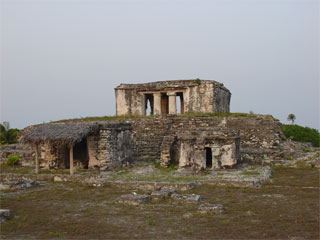

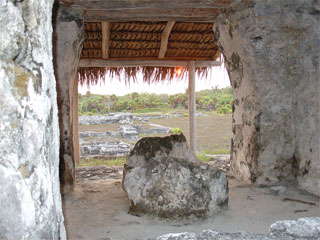
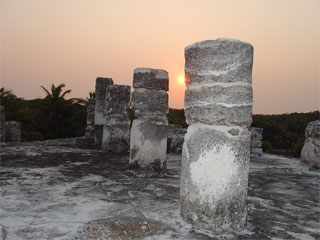
This year we visited three ruins during the trip. The Chac Mool ruins are located at Playa Blanca and this year I visited them at sunset instead of sunrise like last year to see them in a new light. The ruins at Tupac were impossible to get to because of the low water that the area was having this year. On our return to Cancun we visited the ruins at Chichen Itza one day then went to Tulum the next day.
The Chac Mool ruins are found on-site at Playa Blanca, just a short walk from the lodge. The complex consist of a pyramid, a main temple with the Chac Mool statue and a number of platforms. Last year I shot the ruins at sunrise but this year decided to try them at sunset.
 |
 |
| The Temple | The pyramid at sunset |
 |
 |
| The Chac Mool | The pillars atop the pyramid |
Chichen Itza is the most spectacular ruin in the Yucatan Peninsula and was once a major city for the Mayan people with a population of 50,000 - 100,000 from around 650 - 1250 A.D. I was having some serious eye issues the day we visited and was roaming the ruins in a partial daze, looking back on it afterwards I realized I was in a very dreamlike state the whole visit which was probably a good state to be in for this ancient ruin. The Itzae people created the city in the post-Toltec era so it has a heavy Toltec influence with the Quetzalcoatl/Kukulcan beliefs and so I felt very close to the imagery there. My mind state was very much like the mitote mind states I'd experienced in my Toltec work several years ago and was fitting for this place. The mitote was traditionally an all-night ceremony involving peyote but the modern day mitote used by don Miguel was done using chanting and slight sleep deprivation which led to a very dreamlike state even when awake.
Upon entering the ruins you are immediately struck by the Castle of Kukulcan which rises about 100' from the central plain of the city. This pyramid is famous for the equinox shadow experience of the Feathered Serpent of Kukulcan which descends down the staircases from the top to the earth.
 |
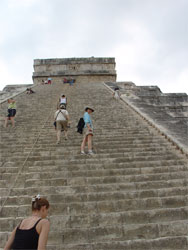 |
|
The Castle of Kukulcan |
Ascending the stairs |
From the top the view of the Ballcourt is very impressive, as is the view to the central and southern regions of the ruins. You can really see how dense the jungle is in this part of the Yucatan. Looking the other direction you can see the Temple of the Warriors and the thousand columns surrounding it.
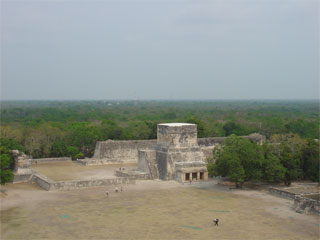 |
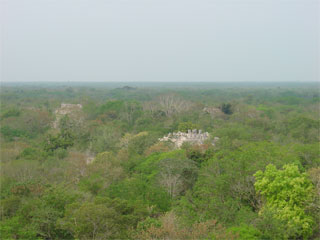 |
| The Ballcourt from the top of the Castle. This is the largest ballcourt in Central America. | The Central and South ruins from the Castle |
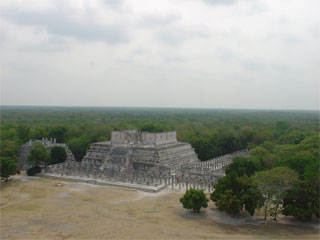 |
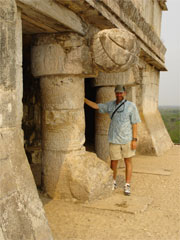 |
| The Temple of Warriors from the Castle | On top of the Castle |
After carefully descending the Castle we roamed around the rest of the main group of ruins which included the Ballcourt, the Temple of the Warriors, the Group of a Thousand Columns, and some other smaller platforms.
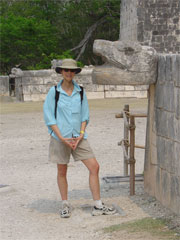 |
 |
 |
| At the corner of the ballcourt | The Castle in back of the Tzompantli - the platform made of carved skulls that was used to display the heads of sacrifice victims. | The Group of a Thousand Columns near the Temple of the Warriors |
The Platform of Jaguars and Eagles held a special place for me, going through my apprenticeship period of a year as a Jaguar for the first six months and an Eagle for the last six months.
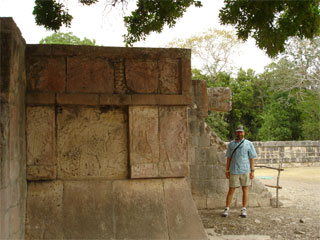 |
 |
| By the Platform of Jaguars and Eagles | Detail of the Jaguar and Eagle panels |
We then headed to the Sacred Cenote on the far north of the complex. The cenote is a huge natural well that is thought to have been revered as a home of the rain god Chac and was used for sacrifices.
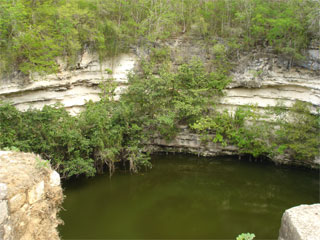
We then went to the central and southern groups of ruins where the highlight for me was a full-on astronomical observatory.
 |
 |
| The Observatory | The Church which is part of the Nunnery complex |
 |
|
| The Nunnery | |
For more information on Chichen Itza I found this great site on the net - Welcome to Chichen Itza.
On our last day in Mexico we got up early and drove to the ruins at Tulum, on the shores of the Caribbean. We arrived just as they opened which was a good thing because by the time we were leaving the tour buses were there in full force. Tulum was a much smaller city than Chichen Itza and not nearly as spectacular. Still, the beauty of the site on top of the cliffs with white sand beaches below made it worth the excursion. The area around El Castillo was under renovation so we were unable to climb it or get close to the structures there.
The city of Tulum was built later than Chichen Itza and was inhabited from 1200 A.D. until the conquest. It was tied with the cult of the Descending God which, according to one tour guide, came down at this spot and told the people to stop the practice of sacrifice. It was a city that was built for trade and fires in the some of the temples marked the reef break to allow boats to enter the small bay at the city.
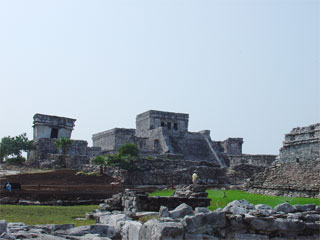 |
 |
| The Castle at Tulum | The Temple of Viento (Wind) |
 |
 |
| The Temple of Frescos | Close up - this temple had the red handprints on it just as did the Tupac ruins on Punta Pajaros |
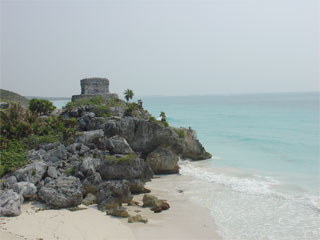 |
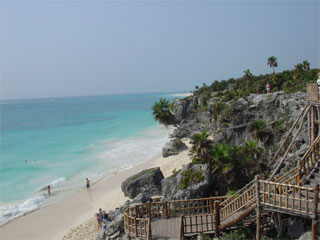 |
| The north tower - this was one of the markers for the reef break | The south tower, the other reef break marker, and the famous beach at Tulum |
After visiting the ruins we headed into the pueblo of Tulum for lunch at Don Cafetos and to visit some of the small shops along the road.
 |
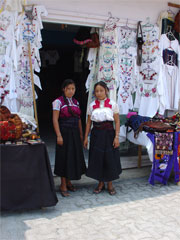 |
| Lunch at Don Cafetos | Mayan girls from Chiapas selling their goods |